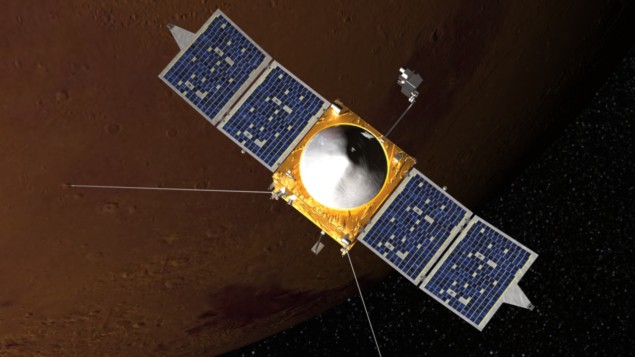
Ageing infrastructure currently orbiting Mars could threaten the viability of future missions to the red planet. That is according to a new report by the National Academies of Sciences, Engineering and Medicine (NASEM), which warns that concludes that the loss of even a single Mars orbiter – essential for communicating with Martian rovers – could make it difficult to support planned sample-return missions to the red planet.
The report – Visions into Voyages for Planetary Science in the Decade 2013-2022: A Midterm Review – provides a series of recommendations to ensure NASA fulfills the goals of the present 10-year survey for planetary science, which began in 2013. Many of the recommendations revolve around Mars including the continued planning and implementation of a Mars sample-return mission. The report also calls on NASA to completely reassess its Mars programme from developing a strategic plan and budget to implementing a new management structure and establishing partnerships – including with commercial firms.
NASA is doing a good job in following the research priorities laid out in the 2013 survey given the very challenging budget situation they were faced with at the beginning of the decade
Louise Prockter
“NASA builds extremely capable spacecraft that frequently last far longer than their design time, which results in a rich and ongoing science return above and beyond what was originally planned,” report co-chair Louise Prockter from the Lunar and Planetary Institute in Houston told Physics World. “However, relying on this ageing infrastructure is a potential risk. We are recommending that NASA evaluate how much of a risk this is.”
Budget woes
The report – written by a 16-strong panel – concludes that NASA’s planetary science division has made “impressive progress” in meeting and even exceeding some of the goals set out in the 2013 decadal survey. It has done so despite significant cuts in its budgets early in the current decade. “NASA is doing a good job in following the research priorities laid out in the 2013 survey given the very challenging budget situation they were faced with at the beginning of the decade,” says Prockter.
Yet budget cuts have affected many aspects of the 2013 survey’s recommendations with the two planned large “flagship” missions having been downsized. The Mars Astrobiology Explorer-Cacher, for example, re-emerged as the Mars 2020 rover, which will launch in 2020 to collect samples for eventual return to Earth to look for signs of life. The Jupiter Europa Orbiter, meanwhile, is now the Europa Clipper mission. Set to launch in the next decade it involves placing a spacecraft in orbit round Jupiter to carry out a detailed investigation of the giant planet’s moon Europa.

Liquid water discovered beneath Mars’ south pole
Opportunities for lower profile Discovery and New Frontiers missions have also declined, with the NASEM panel stating that the timeline for choosing such probes is on the brink of falling behind schedule. Indeed, the report calls on NASA to invite submission for another New Frontiers mission, which have a cost cap of $850m, “as soon as possible” and no later than December 2021.
“NASA has made a strong investment in technology that has exceeded the [2013 decadal survey’s] recommended levels,” says co-chair Joe Rothenberg, a former NASA associate administrator. “This investment has not only enabled science missions in this decade but is providing for the long-term technology development needed for missions in the next decade, including the Mars sample return programme and the exploration of planetary bodies with extreme environments.”



